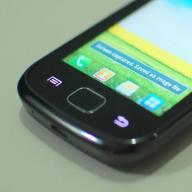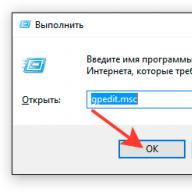Some Windows "glitches" can plunge the user into a complete stupor and despondency. Imagine: you turn on the computer, and instead of the usual desktop dotted with shortcuts and the start button in the lower left corner of the screen, you see only a background with a picture or nothing at all.
A monotonous one-color field without any signs of life, if the background was initially absent. This has the effect of a bomb exploding. The feeling of this is comparable only to the one that would arise if you returned home and find there bare walls with peeling wallpaper. Who stole Windows? Where did the native desktop on Windows XP disappear? What to do in such a situation?
Let's make a reservation right away this problem is specific mainly for the "pig", in other systems, if it takes place, it occurs much less frequently. Therefore, the subject of our further discussion is XP. And although this OS has officially left the scene and is no longer supported by its manufacturer, it is by no means uncommon on the PCs of domestic users. The main reason for this behavior of the system is its defeat by a virus.
Some of these "animals" delete or rename some system files... For example, "Explorer", which is not only a folder viewer file system, but also forms the basis of the GUI (graphical user interface) of all Windows.
By deleting some exe and dll files, the virus prevents the normal operation of the desktop and its display on the screen. Let's consider in order our actions to bring it back to normal.
Where has the "Explorer" gone?
Perhaps nowhere. In this case, there can be two alternatives:
- The explorer.exe file (the Explorer program file) was actually deleted, moved, or renamed.
- The virus has corrupted the registry keys required for it to run normally.
To figure out what exactly happened, the following trick will help us:
- We use the keyboard combination "Ctrl" + "Alt" + "Del" to launch the task manager.
- In the main menu of the dispatcher, select the item "File" => "New task".
- In the window that appears, enter the name of the command: explorer (the extension.exe can be omitted, it is assumed by default).
- Click on "Enter" or the "Ok" button.
 If the program started and no error message was displayed, restart the computer. It may very well be that after rebooting you will see a normal picture on the monitor.
If the program started and no error message was displayed, restart the computer. It may very well be that after rebooting you will see a normal picture on the monitor.
If an error is displayed, it means that the file has been deleted, renamed or moved from Windows folders where it is usually stored.
It is possible that a malicious application is launched instead of Explorer itself. By calling the program manually, we prevented it from starting.
Another way to do the same is to enter the command% systemroot% \ system32 \ restore \ rstrui.exe. Then the table will be restored without rebooting. However, in some cases, this method does not work, even if the explorer is right there. If it is not there, and an error popped up, it means that the file of this program native to XP must be found somewhere else and returned to its place. Let's try some more options:
Safe Mode - to the rescue
Alternatively, try rebooting and starting Windu in one of the safe modes(network support is not essential in this case). As a rule, the desktop is displayed normally in this mode. Next, we do this: we call the system recovery interface from the control panel and roll back to the previous save point.
If the table is not displayed, then enter, as before, rstrui.exe. The command called rstrui.exe is the console version of the system recovery interface.
All this makes sense to do if in normal mode nothing succeeded.
And you can do otherwise. From the boot menu, go directly to support mode command line and run the same commands in the console. To call the conductor, enter the following line in the invitation:
To call the recovery toolkit - this:
Rule the register
Sometimes none of the above helps. Then you need to pay attention to the contents of some particularly important registry keys. But first you need to start the registry itself. This is done in the same way as we launched the "Explorer".
In the menu of the task manager, select the item "File" => "New task", and instead of the aforementioned commands, enter the regedit command in the field - this is the name of the registry program. A window like this will appear:
 On the left side of it we see a tree of sections, on the right - the contents of the keys. On the left we look for the HKEY_LOCAL_MACHINE \ SOFTWARE \ Microsoft \ Windows NT \ CurrentVersion \ Winlogon branch, and on the right we look for a key named "shell".
On the left side of it we see a tree of sections, on the right - the contents of the keys. On the left we look for the HKEY_LOCAL_MACHINE \ SOFTWARE \ Microsoft \ Windows NT \ CurrentVersion \ Winlogon branch, and on the right we look for a key named "shell".
Then go to the HKEY_CURRENT_USER \ Software \ Microsoft \ Windows \ CurrentVersion \ Policies \ Explorer section and find the NoDesktop key there. Its value should be equal to 0, if it is not - correct it.
And the final touch: clear the value of the "shell" key from the HKEY_CURRENT_USER \ Software \ Microsoft \ Windows NT \ CurrentVersion \ Winlogon \ branch. It must be empty. After the work done, we restart the computer.
That, in fact, is all that can be created with the desktop in the event of its incorrect loading.
The desktop disappeared: shortcuts and the taskbar with the \ "Start" \ menu do not appear.
What to do if shortcuts and the taskbar with the \ ”START” menu \ ... disappeared from the desktop
The article is applicable for Windows 2000 / XP / Vista / 7.
Requirements.
To complete the steps in this article, you must have local administrator rights on your computer. The article is applicable for Windows 2000 / XP / Vista / 7.
Information.
If the desktop does not appear when the computer boots, i.e. instead of the usual shortcuts and the taskbar, only the background image is displayed on the screen, then most likely your computer has been attacked by viruses (unless, of course, you yourself have broken something).
Restoring the desktop.
Attention!
Before performing the steps in this article, check your computer for viruses. Otherwise, you will correct errors, and after rebooting the viruses will again do everything as they need to.
Method number 1.
Let's start with the simplest. You need to check the option that disables the display of icons on the desktop:
Windows 2000.
2. In the menu that opens, select the item \ "Active Desktop" \;
Windows XP.
1. Right click on the desktop;
2. In the menu that opens, select the item \ "Arrange icons" \;
3. In the expanded submenu, next to the item \ "Display desktop icons" \ there should be a check mark. If there is no check mark, then click on this item.


Windows Vista.
1. Right click on the desktop;
2. In the menu that opens, select the item \ "View" \;
3. In the expanded submenu, next to the item \ "Display desktop icons" \ there should be a check mark. If there is no check mark, then click on this item.
Note. The result will not appear immediately, but with a delay of 3 - 10 seconds, it all depends on the performance of the computer and its \ "clutter" \.
Method number 2.
If method # 1 did not help, then we try to start the explorer.exe process manually. One of its tasks is to display the desktop:
1. On the keyboard, press and hold the \ ”Ctrl” \ and \ ”Alt” \ buttons, and then press the \ ”Delete \” button;
2. In the \ "Windows Task Manager \" window, go to the \ "Applications \" tab;
3. On this tab, click the \ "New task" \ button;
4. In the \ ”Create a new task” window \ in the \ ”Open” \ field, type the explorer.exe command and click the \ ”OK” button \;
5. Restart your computer;
Method number 3 - For Windows XP / Vista only.
If in method number 2 an error appears that the explorer.exe file was not found or after the restart the problem remains, then you must try to do a system restore:
1. In the \ "Start" \ open in sequence:
\ ”Programs” \ ”\” Standard ”\” \ ”Service” \
2. In the menu \ "Service" \ click on the item \"System Restore"\;
Note... If there is no such item, then follow these steps:
- In the menu \ ”Start” \ select \ ”Run” \;
- In the open field, type the command % SystemRoot% \\ system32 \\ restore \\ rstrui.exe
- press the button \ "OK" \;
3. In the \ "System Restore" \ on the right side of the window, select \ "Restoring an earlier state of the computer" \ and press the button \"Further"\;
4. In the calendar, select a day with a breakpoint, such days are highlighted in bold;
Note... Choose a day on which your computer worked normally, i.e. if you remember that the computer started normally three days ago, then choose the point three days ago. If a control points no, then most likely you have disabled the option of creating control points and you will have to go to method number 4.
Also read the article \ "Enabling and disabling System Restore in Windows XP" \.
Method number 4.
If system restore did not help, then you will have to go into the system registry:
1. On the keyboard, press and hold the buttons \ ”Ctrl” \ and \ ”Alt” \ and then click \ ”Delete” \;
2. In the window \ "Windows Task Manager \", go to the tab \ "Applications" \;
3. On this tab, click the \ "New task ..." \;
4. In the \ "Create a new task \" window in the \ "Open" \ field, type the command regedit and press the button \"OK"\;
5. In the \ "Registry Editor \" window on the left side of it, sequentially expand the registry keys to the section \ ”Image File Execution Options” \:
HKEY_LOCAL_MACHINE / SOFTWARE / Microsoft / WindowsNT / CurrentVersion / Image File Execution Options /
6. Open the \ ”Image File Execution Options \” section and look for the subsections \ ”explorer.exe” \ and \ ”iexplorer.exe” \;
If any of the subsections is found, then it must be deleted.
7. Click on the subsection with the right mouse button and in the menu that opens, select the item \ ”Delete” \;
8. At the request for confirmation of deletion, press the button \"Yes"\;
9. Now let's check the launch parameters explorer.exe, for this we expand the registry keys to the section \ ”Winlogon” \:
HKEY_LOCAL_MACHINE / SOFTWARE / Microsoft / WindowsNT / CurrentVersion / Winlogon /
10. Left-click on the section \ ”Winlogon” \ and in the right part of the registry editor window we find the parameter \ ”Shell” \;
11. Right-click on this parameter and select the menu item \ ”Change” \;
12. In the window \ "Changing the string parameter" \ in the field the value should be written explorer.exe and nothing else, if this is not the case, then correct it;
13. Press the button \"OK"\, close all windows and restart your computer;
Article taken from open sources: http://www.pc-problems.ru/index.php?s=4&idk=17&idpk=23&ida=128
Sometimes when Windows startup XP users are faced with an unpleasant situation - the desktop with all the folders, program shortcuts and the Start menu disappeared, and it is impossible to restore it by updating through the context menu. But do not panic: you can restore the Windows graphical shell, the main thing is to know what changes need to be made to the system configuration.
Only shortcuts disappeared
If the taskbar with the "Start" menu remains, but the shortcuts from the desktop have disappeared, then you can restore them through the context menu.
Labels should go back to Windows table XP, if they are not forcibly removed by someone.
Disappeared desktop elements
If after turning on windows XP you saw empty table(there are no shortcuts, no Start button), then restart your computer first. Then perform a system restore to a previous state where there were no problems with displaying the desktop.
If the problem reappears after a system restore, then check if the graphical shell is running.

This executable file is responsible for the graphical shell of Windows XP, so when you start it, a table with fixed elements will appear. If a message appears that the file was not found, then you need to copy it from the Windows XP distribution to restore the desktop.
If the table appears, check Windows for viruses with a utility like Dr. Web CureIT... If the reason for the loss of the table was a virus infection, then deleting the malicious code should help fix the problem.
Editing the registry
If launching the graphical shell file returned the desktop to its place, but the problem reappeared on the next boot, then check several parameters of the system Windows registry XP. Sometimes, as a result of viruses, the desktop startup parameters change their value, and in order to return the system to a normal state, you need to restore the previous settings.

If "Shell" is set to a different value, double-click the left button and write in the correct data. Go back to the "Current Version" section on the same registry branch and expand the "Image File Execution Options" subsection. You will see the item "explorer" or "iexplorer" inside - delete it, this is a section created by a virus. 
After making edits to windows registry XP restart your computer. When you restart it, the table should be displayed correctly. If the "Start", notification bar and icons are in place, then the restoration through the registry editor went fine.
The shell file is corrupted
Let's consider a more difficult situation in which the Windows XP graphical shell file is not detected by the system or is damaged. To restore the graphical shell, you need to transfer the normally working explorer.exe file to the Windows directory.
Note: This method may require the use of a second computer.

The restore of explorer.exe is complete - no more problems with displaying the workspace should occur.
If you are faced with the problem of restoring shortcuts on the desktop, then this article will help you in this matter and if you follow its instructions, you can quickly solve this problem.
The problem looks like this: “I downloaded three programs from the Internet and decided to test them in action. But after installing the second program, suddenly all the shortcuts on the desktop and in the menu Start changed their icons to the white icon blank slate... Shortcuts stopped working - apps won't launch. how restore working capacity desktop shortcuts?”.
Let's try to understand as much as possible in detail. possible ways restore shortcuts.
Restoring the work of shortcuts on the desktop
Exists 2 main ways restore shortcuts:
- Automatic, with a special program.
- Manually through the computer registry.
Automatic method restore shortcuts
Free utility Unassociate File Types specially designed to restore values system registry and with it restoration of action of shortcuts.
- For this download program and launch her.
- After that, in the utility window you need to find " . lnk "- highlight him and press " Remove file association (User)«

Now you need to be sure to complete restart your computer. After that, the problem should be resolved.
Restoring the work of shortcuts on the desktop manual mode
In order for the shortcuts to display correctly, certain files of a special type are pinned to their properties. If you have a blank sheet icon instead of a beautiful shortcut icon, then the very files of a special type are corrupted. With the help of this instruction, you should definitely cope with the problem that has arisen.
- Press the key combination “ Win + R", Then in the command line type" regedit" and press Enter ( or " OK« ) .

- In the window that opens, go through the registry tree: HKEY_CURRENT_USER -> SOFTWARE -> Microsoft -> Windows -> CurrentVersion -> Explorer -> FileExts -> . lnk .
- Call the context menu by right-clicking on the section UserChoice (if available)... In the menu that opens, select the item " Delete”. Confirm your intention by clicking on the button “ Yes”. Close the window Systemic Registry .

- Reboot a computer.
Restarting the desktop using the task manager
If after the steps to restore the desktop shortcuts, you will be faster restart desktop using task manager, then you can try to accomplish this using detailed description process.
In order to restart the desktop, read the instructions carefully to the end and copy to the clipboard explorer.exe(which will need to be started by a new task in the manager), so after the process is turned off, the desktop and this instruction with the browser will be unavailable
In order for the changes made to restore shortcuts to take effect without restarting the computer, and after restarting the desktop, press the key combination “ Ctrl + Alt + delete "- the main window will open Task manager ... Go to the tab Processes -> find in the list of processes “ explorer.exe”-> select it and right-click to terminate the process (or by selecting it, stop it with buttons “ End the process” located below ) — then disappear desktop along with shortcuts.

- Further in the same window Task manager “” -> click on the file button, select “ New challenge”

- Now enter the command “ explorer.exe"-> click on the button" OK”. Thus, we have included Desktop.





